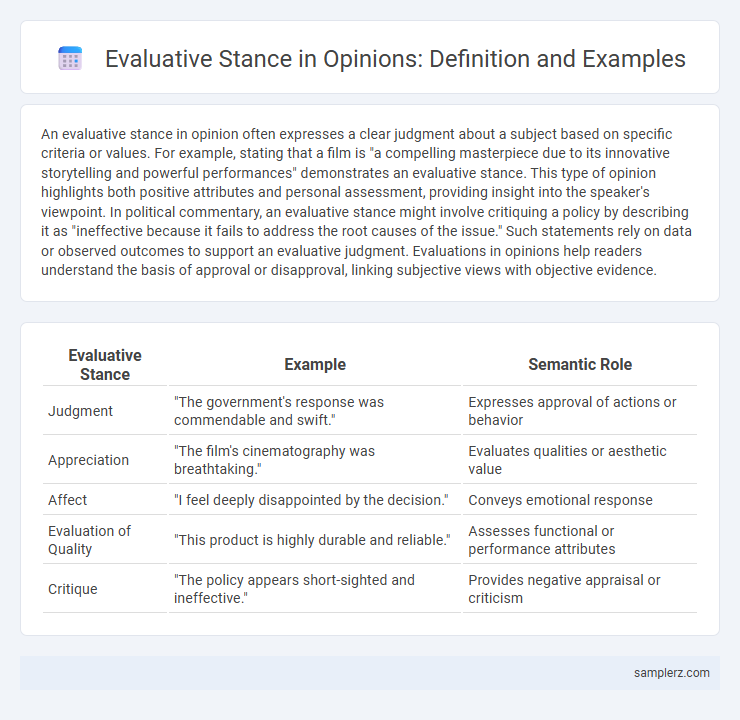An evaluative stance in opinion often expresses a clear judgment about a subject based on specific criteria or values. For example, stating that a film is "a compelling masterpiece due to its innovative storytelling and powerful performances" demonstrates an evaluative stance. This type of opinion highlights both positive attributes and personal assessment, providing insight into the speaker's viewpoint. In political commentary, an evaluative stance might involve critiquing a policy by describing it as "ineffective because it fails to address the root causes of the issue." Such statements rely on data or observed outcomes to support an evaluative judgment. Evaluations in opinions help readers understand the basis of approval or disapproval, linking subjective views with objective evidence.
Table of Comparison
| Evaluative Stance | Example | Semantic Role |
|---|---|---|
| Judgment | "The government's response was commendable and swift." | Expresses approval of actions or behavior |
| Appreciation | "The film's cinematography was breathtaking." | Evaluates qualities or aesthetic value |
| Affect | "I feel deeply disappointed by the decision." | Conveys emotional response |
| Evaluation of Quality | "This product is highly durable and reliable." | Assesses functional or performance attributes |
| Critique | "The policy appears short-sighted and ineffective." | Provides negative appraisal or criticism |
Understanding Evaluative Stance in Opinion Writing
Evaluative stance in opinion writing involves expressing judgments, attitudes, and values toward a subject, often through the use of evaluative language such as adjectives, adverbs, and modal verbs. This stance helps readers discern the writer's perspective by highlighting positive or negative qualities and emphasizing the significance or impact of the argument. Effective understanding of evaluative stance enables clearer communication of opinion and strengthens persuasive writing through nuanced assessments.
Key Features of Evaluative Stance in Opinions
An evaluative stance in opinions involves expressing judgment through clear criteria and subjective assessment, often highlighting qualities such as effectiveness, importance, or impact. Key features include explicit evaluative language, use of comparative adjectives, and justification supported by evidence or personal experience. This stance allows the writer to convey a personal viewpoint while appealing to the audience's values and reasoning.
Language Markers of Evaluation in Opinions
Language markers of evaluation in opinions frequently include adjectives like "crucial," "ineffective," and "outstanding," which convey clear judgments. Modal verbs such as "should," "must," and "could" express obligation or recommendation, reinforcing the speaker's stance. Intensifiers like "very," "extremely," and "highly" amplify the evaluation's strength, shaping the reader's perception effectively.
Examples of Evaluative Adjectives in Opinions
Evaluative adjectives such as "wonderful," "terrible," and "mediocre" play a crucial role in shaping opinions by providing clear judgments about quality or value. These adjectives help convey the writer's attitude towards a subject, making the opinion more persuasive and emotionally impactful. Using precise evaluative adjectives enhances clarity and allows readers to quickly grasp the significance of the opinion expressed.
Role of Evidence in Expressing Evaluative Stance
Evaluative stance in opinion writing relies heavily on credible evidence to strengthen claims and persuade the audience effectively. The integration of statistics, expert testimonials, and documented examples provides a solid foundation that validates subjective judgments and opinions. Without such evidence, evaluative statements risk being perceived as mere personal bias rather than informed assessments.
Comparative Statements as Evaluative Tools
Comparative statements in opinions serve as powerful evaluative tools by highlighting differences in quality, performance, or value between entities. For example, stating that "Product A offers better durability than Product B" conveys a clear judgment that guides consumer preferences. Such comparisons sharpen the evaluative stance by providing concrete benchmarks, enhancing the persuasiveness and clarity of the opinion.
Using Modality to Convey Evaluation
Using modality to convey evaluation allows writers to express degrees of certainty, obligation, or permission, which shapes readers' interpretation of opinions. Modal verbs such as "must," "should," and "might" signal different levels of commitment to the evaluative stance, enhancing the tone's nuance and persuasiveness. This technique enables precise communication of attitudes toward a subject, reinforcing the opinion's overall impact.
Personal Judgments in Opinion Texts
Personal judgments in opinion texts reveal the author's subjective evaluation, often expressed through adjectives and adverbs that convey approval or disapproval. These judgments shape readers' perceptions by highlighting positive or negative attributes of a topic, event, or individual. Examples include phrases like "remarkably effective" or "deeply disappointing," which emphasize the writer's stance and influence audience interpretation.
Balancing Subjectivity and Objectivity
An effective evaluative stance in opinion writing balances subjective insights with objective evidence to enhance credibility and engagement. Incorporating personal judgment alongside verifiable data or statistics enables readers to relate emotionally while trusting the assessment's validity. This equilibrium supports nuanced arguments that acknowledge complexity rather than presenting overly biased or detached viewpoints.
Evaluative Stance in Persuasive Arguments
Evaluative stance in persuasive arguments involves the strategic use of positive or negative language to influence the audience's perception of a subject. This stance often incorporates value-laden adjectives and adverbs that highlight the importance, effectiveness, or moral standing of an argument. By embedding evaluative language, speakers and writers reinforce their viewpoint and persuade the audience to adopt a similar evaluation.

example of evaluative stance in opinion Infographic
 samplerz.com
samplerz.com